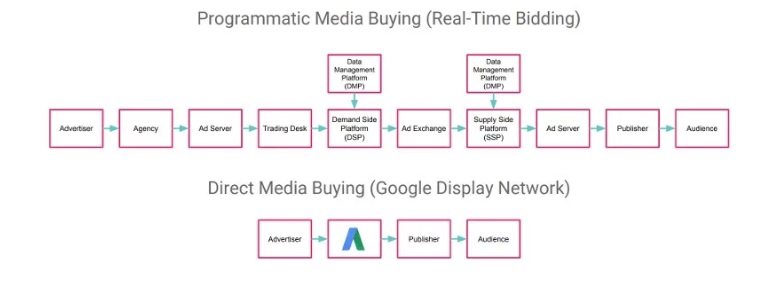With every passing year, the digital marketing industry develops more and more technologies and methods. That means there’s an increase in the tactics and tools available for advertisers and performance marketers – which is a good thing. But it also means lots of complicated-sounding terminology being thrown around, and sometimes it can be hard to keep up.
Even when it comes to well-known concepts we’ve been hearing about for a long time (like display advertising), and others that are somewhat newer (like programmatic), it can be hard to get the definitions straight. So, we are going back to basics, and looking at programmatic versus display network advertising – what they are, how they are used, how they are different and what advantages they offer. Here goes!
What is Display Network Advertising?
Display advertising is one of the ‘oldest’ types of online advertising, having been around since the mid-1990s. Display ads come in the form of banners, in different sizes, which are served to online audiences via display ad networks. Google’s ad platform, called the Google Display Network (GDN), is one of the most well known – according to Google, it has over 2 million websites and reaches more than 90% of people on the internet. But there are plenty of other display ad networks, including Yahoo, Bing, Conversant and dozens more. Learn more about how display advertising works in our post about Native Vs Display Advertising.
What is Programmatic Advertising?
Programmatic advertising is not an ad network – rather it is an automated way of buying advertising space via algorithm-based technology to get the most accurate ad placement in the fastest time at the best price. Programmatic advertising is sold via ad exchanges. Publishers offer ad space to be bought programmatically, and advertisers enter automated bids to buy programmatic ad space in real time according to advanced analytics that help determine where to place the ad and get the most impressions for the best bid. It’s all done in an instant on an ad exchange, of which there are dozens. Here’s a deeper look at how programmatic advertising works.
What Are the Differences – and Advantages?
While display network advertising takes place on a closed network, programmatic is a method of buying ad space that involves multiple ad exchanges. Both display network and programmatic advertising use advanced data analytics and software to get the most effective ad placement. However, given the vast inventory covered by programmatic advertising, the process involved is much more complex.
The image below, courtesy of Spatially, gives a great visual overview of the linearity of direct media buying typical of display network advertising versus the programmatic method.

So what are some of the differences of programmatic versus display network advertising? Let’s take a look:
Reach
A key difference in display network and programmatic advertising is reach. Display networks are closed advertising ecosystems – although huge, they are limited to the websites that are part of their network. Programmatic advertising is a platform that covers inventory from multiple ad exchanges, supporting a truly massive inventory that expands the advertiser’s potential reach, meaning ads can be seen by far more people than they otherwise would on a display network.
Type of ads
Programmatic and display network advertising platforms both support a wide variety of ad types, including video and interactive HTML5. However, while display ads look like ads, native programmatic ads do not. Native ads are designed to fit seamlessly into the design of the web page they appear on. For this reason, native advertising is an effective antidote against banner blindness, helping to boost customer engagement and brand awareness. When bought programmatically, native advertising can really supercharge performance marketing results.
Targeting options
While both display network advertising and programmatic advertising support advanced audience targeting, including remarketing and custom audiences, programmatic advertising typically provides a richer range of options. This is due to the sheer volume of user-generated data that is available for analysis via programmatic advertising. Unlike display networks, with programmatic, the advertiser is not limited to the websites in the network, so there is far more opportunity for audience segmentation and focused targeting via third-party networks.
Speed and cost efficiency
A key advantage of programmatic advertising is the automated, real-time nature of ad buying. This makes the whole process faster and more efficient. With programmatic, all the manual work of buying ad placements, targeting and analyzing is done in an instant, via a central dashboard where the advertiser can manage and monitor their ad campaigns strategically and effectively. Programmatic removes the middleman, enabling advertisers to bid in real time for the best ad placement at the lowest price on numerous ad exchanges at once, using AI-driven algorithms created to enhance reliability of results.
To sum up, some numbers…
When it comes to both programmatic and display network advertising, you’re talking big business. In 2019, it is predicted that nearly $47 billion will be spent in the US on display advertising. According to eMarketer, that same amount was spent on programmatic advertising in 2018, and by 2020, programmatic will account for 80% of video advertising and 90% of mobile display ads.
Both programmatic and display network advertising are key elements in every well-rounded digital marketing strategy. The real question is when, where and how to use each in order to boost your ROI and maximize your online advertising results.